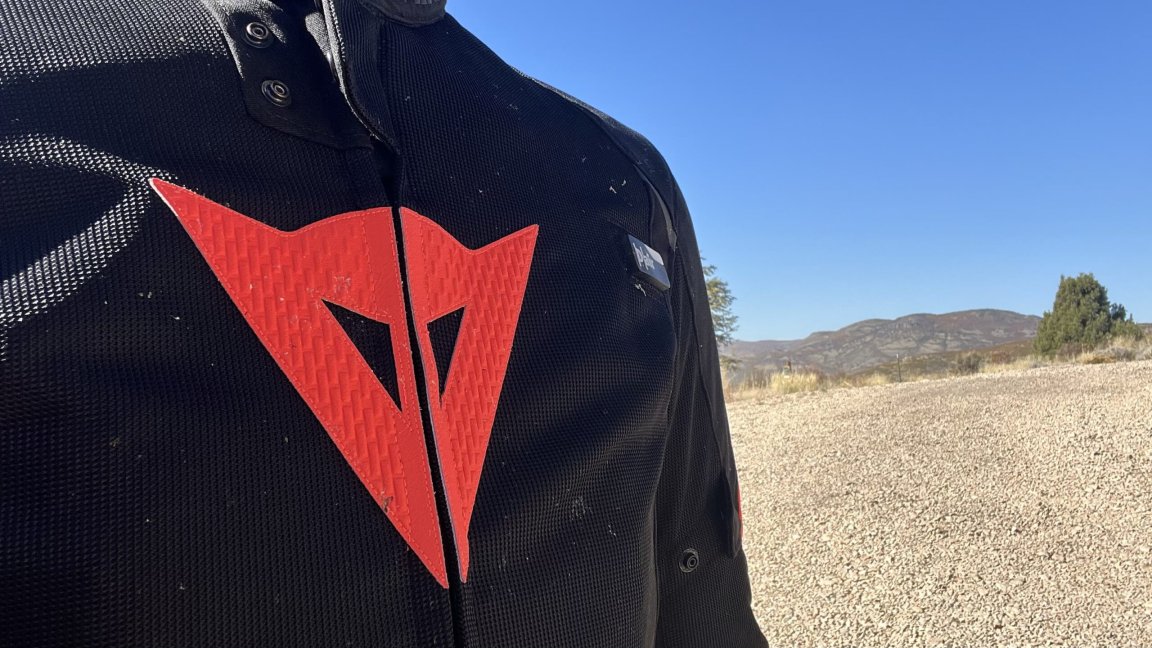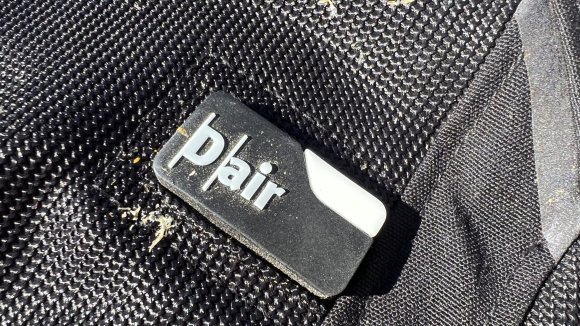We may earn revenue from the products available on this page and participate in affiliate programs. Learn more ›

As most seasoned riders will tell you, it’s not a matter of if you fall off, it’s a matter of when. For a long time, this wasn’t something I wanted to believe. But I was forced to when I came helmet to hood with an old Mercedes E-Class. Now, I accept wholeheartedly that I could be involved in an accident each time I throw a leg over, and you should feel the same way. So, it only makes sense to protect yourself as much as possible every time you ride.
Motorcycle airbag vests disperse three to four times the amount of energy that top-spec passive armor does. This gear could literally be the thing that saves your life, and you barely even notice you’re wearing it. But it’s a relatively new technology, and as such, it can be hard to know what product is right for you. Well, keep reading, and I’ll decipher the mystery.
Summary List
- Best Overall: Alpinestars Tech-Air 5 System
- Best Value: Klim Ai-1 Airbag Vest
- Best Premium: Dainese Smart Sport Jacket
- Best Over-Jacket: Helite Turtle 2 Airbag Vest
Our Methodology
I’ve been riding since I was 11 years old. I saw neck braces enter motocross, the evolution of D30 armor, and motorcycle airbag vests go from testing in MotoGP to on sale for the general public. The point is that I stay abreast of all advancements in the motorcycle gear industry, particularly as it pertains to safety.
Motorcycle airbag vests are the latest and greatest technology, meaning I pay particularly close attention to them. So, even though I haven’t had the chance to test all the products on this list, my institutional knowledge informs my decisions. However, I reserve the right to change my choices as the niche progresses.
Best Motorcycle Boots: Reviews & Recommendations
Best Overall: Alpinestars Tech-Air 5 System
Pros
- Works with virtually any jacket
- Six triaxial integrated sensors
- 30 hours of riding time
- Race and street use
- 20-40 ms inflation time
Cons
- Micro-USB charger
- Single activation before recalibration
Alpinestars was the first company to launch an airbag vest to the general public, and it’s built on this foundation with user data ever since. That’s why, even though airbag vests are very closely matched in terms of features, the Alpinestars Tech-Air 5 System just edges out the competition. This model fits under virtually any jacket as long as you have 4cm of additional space around the circumference of the body. The vest covers the chest, ribs, and full back. It decreases impact force by 95% compared to a passive protector.
This model uses an active electronic system that features six triaxial integrated sensors and a crash algorithm that leverages AI to monitor when to deploy. When it’s time to deploy, the whole process takes between 20-40ms and is powered by argon gas canisters, which are included in the sale. The jacket has a battery life of 30 hours, and it takes around five hours to recharge.
My biggest gripe with the Tech-Air 5 System is the fact that it uses a micro-USB charger. Nowadays, USB-C cables are far more common and result in faster recharge times. After the system has been deployed, you need to send it back to Alpinestars’ HQ. Here, team members will inspect, repack, recharge, and bring the system back to full operational status for $229. Regardless of whether it’s been deployed or not, you need to get the vest calibrated by Alpinestars every 24 months.
Best Value: Klim Ai-1 Airbag Vest
Pros
- Low initial cost
- Detection and inflation in less than 60 milliseconds
- Fully wireless
- 25 hours of use and a 3-hour charge time
- Integrated CE EN1621-2 certified static back protector
Cons
- Subscription model could prove more expensive for some
The Klim Ai-1 Airbag Vest will be the best value vest, by far, for some riders but not for others. Let me explain. This vest uses a subscription model that has various benefits depending on what payment option you choose. If you opt for the one-time lifetime purchase, which costs $399, this vest will cost as much as the top vests on the market. But, if you’re a fair-weather rider who usually only rides during the summer, you can opt for the $12 monthly subscription and save. The fully wireless vest detects and inflates in less than 60ms, which is ever so slightly slower than others on this list. But, on the plus side, you get three deployments before the vest needs a technical evaluation, which is quite a bit more than most competitors.
This model received a 5-star SRA rating and is certified to CE prEN 17092-6, and there’s an integrated CE EN1621-2 certified static back protector built-in. So there’s plenty of protection on offer.
There are rider-selectable Street and Adventure modes, but this model isn’t intended for hard off-road riding, and there’s no Track Mode available in the U.S. You’ll get about 25 hours of battery life, and you can check the jacket’s status via the LED indicators on the control unit. It takes approximately three hours to fully recharge. Like most airbag vests, this model will fit under the majority of jackets as long as they allow enough room for deployment.
Best Premium: Dainese Smart Sport Jacket
Pros
- Extremely breathable
- All-in-one jacket and airbag system
- Seven on-board sensors
- Pro Armor CE level 2 type B protectors at shoulders and elbows
- 26-hour battery life
Cons
- Needs to be inspected after each activation
- Hefty price tag
Managing Editor, Jonathon Klein has put his trust into the Dainese Smart Sport Jacket, and you can read all about that here. Klein writes, “I love Dainese’s Smart Jacket LS Sport… I felt safer than I have in my standard jackets because of D-Air. It offered me an extra layer of protection where standard armor can’t. I felt as if I could ride a little bit faster and have more fun…”
This jacket is more expensive than the competition, but remember, it’s a whole jacket. As well as the D-Air system, this jacket has Pro Armor CE level 2 armor at the shoulders and elbows. And you get all of this in a package that weighs about four pounds. If you’re looking for a summer jacket that offers more upper-body protection than a typical race suit, you’ve found it.
Your riding data is monitored 1,000 times per second, and the algorithm can even detect collisions when stopped, e.g. a rear-end collision. This model’s chest protection meets or exceeds CE level 2 for airbags, and the back protection meets or exceeds CE level 1 for airbags. The Smart Jacket has a 26-hour battery life and recharges in approximately four hours via a USB-C charging cable. After the D-Air system has been activated, you can’t use it again until an authorized dealer has inspected it. And that’ll cost you $250 each time, which tacks onto an already hefty initial price tag.
Best Over-Jacket: Helite Turtle 2 Airbag Vest
Pros
- Wear over any jacket
- Can be reused with fresh CO2 cartridge
- 600D textile construction
- SAS-Tec CE level 2 back protector included
- Inflates in 0.1 seconds
Cons
- Tethered to bike with lanyard
If you’re looking for an airbag vest that you can throw on over any jacket, whether you’re commuting to work or doing a track day, get the Helite Turtle 2 Airbag Vest. As mentioned, you can wear this vest over a regular or motorcycle jacket, and its 600D textile construction with inner 3D mesh should keep it from tearing in the event of a crash. Built into the vest is a SAS-Tec Level 2 back protector, adding another level of protection.
If you activate the airbag and it’s still in good condition (no holes or tears), you can reset it yourself, which only takes about two minutes. This model has the fastest inflation time of any vest on my list, taking just 0.1 seconds, and it inflates via a CO2 cartridge in a hidden pocket. By far, the biggest drawback to this model is that it’s mechanically triggered via a lanyard attached to your motorcycle. So, if you forget to disengage it before hopping off, you’ll be in for a mini heart attack.
Our Verdict
Whether it’s battery life, price, or recalibration charges, the Alpinestars Tech-Air 5 System ekes out advantages over its direct competitors. With that said, if you’re more of a fair-weather rider, you could find more value in the Klim Ai-1 Airbag Vest.
Features to Consider When Buying Motorcycle Airbag Vests
Here’s everything you need to consider when buying a motorcycle airbag vest.
Key Features
Inflator and Inflation Time
The effectiveness of a motorcycle airbag vest is determined by the speed at which it can inflate. So, it’s important to check the deployment time of the inflator. This usually varies, depending on the brand and model. The best airbag vests can deploy in 0.1 to 0.3 seconds (100-300 milliseconds). The best motorcycle airbag vests on the market use 40-60cc CO2 cartridges. These are usually activated by a rip-cord style pull and inflate almost instantly when you crash or lose your bike.
Location of the Activation System
All tethered motorcycle airbag vests have a high-speed airbag deployment system controlled by a coiled wire cord. The vest is normally attached to the bike using a quick-release connection located in the chest area. For safety reasons, the airbag deployment system and its CO2 cartridge must be positioned on the right side of the lower abdomen. This particular area isn’t near any vital organs.
Abrasion Resistance
Motorcycle airbag vests, unlike car airbags, are generally meant to be reusable. So, they must be made with abrasion-resistant material to resist erosion, scratches, and extreme weather. Their outer shell and inflatable airbag must remain intact after a crash. However, some scuffing is acceptable. Get a vest with a tough, abrasion-resistant shell material that complements the impact cushioning the airbag provides.
Coverage
When it comes to safety, the more coverage, the better the vest. Look for an airbag vest that offers maximum protection to your most sensitive body parts. Motorcycle airbag vests do not provide the same amount of coverage; however, most inflate to cover the torso, the rib cage, and the spine. It’s also important to get a vest with a wraparound neck airbag as it will protect your neck when you crash. You can also consider getting a pop-down airbag that protects the tailbone.
FAQs
You’ve got questions. The Drive has answers.
If the airbags and corresponding mechanisms are still in working order you can wear it again. Just be sure to check that the material and other components of the vest are intact. And most importantly, before you wear it again replace the CO2 cartridge.
Yes, but make sure the raincoat and backpack are somewhat loose so that there is room for the airbag to deploy. Otherwise, you will counter the effects of the vest.
The coiled wire will pull you back towards your bike. Fortunately, the airbag will not deploy. It may take some practice for you to get used to the coiled wire, but the added safety benefit is worth it.






